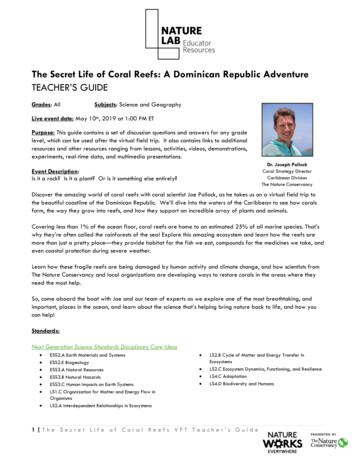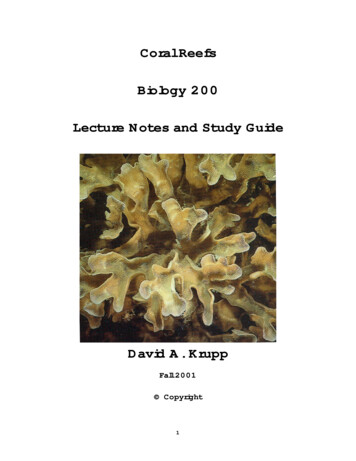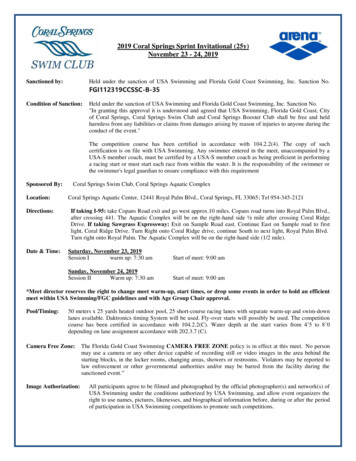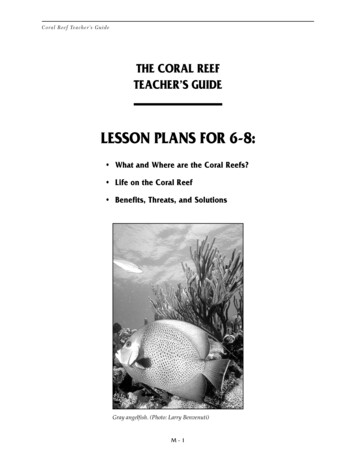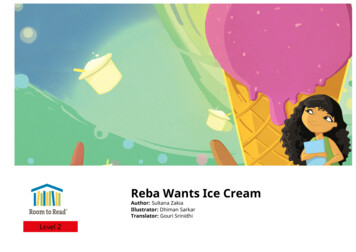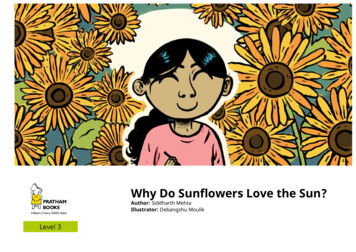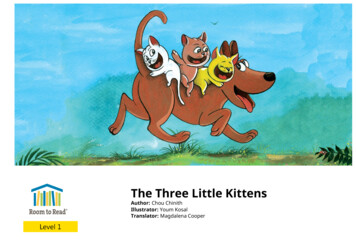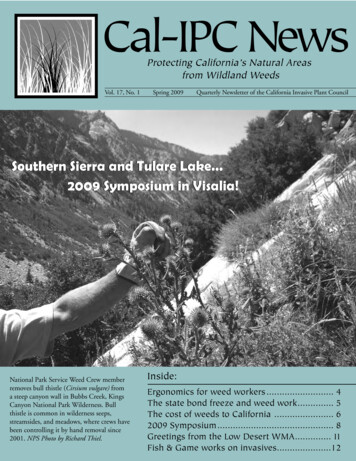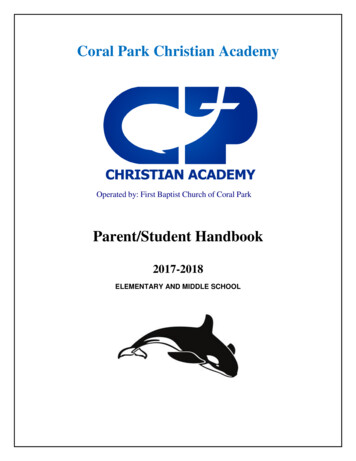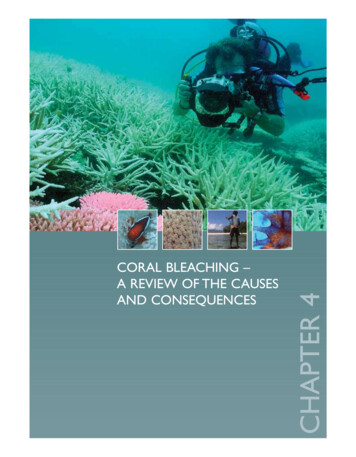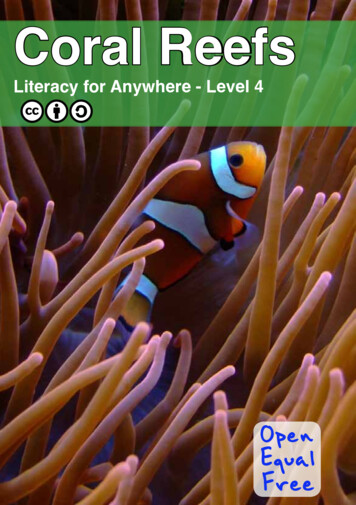
Transcription
Coral ReefsLiteracy for Anywhere - Level 401
Print Me!Copy Me!Share Me!Coral ReefsLiteracy for AnywhereLeveled Readers for the Developing World and Beyond!How to Use Literacy for AnywhereThis is a Literacy for Anywhere level 4 book. This text is designed for studentsin year one or grade one in school. Ideally, first grade students will bereading level one texts independently by the end of the year, second gradestudents will be reading level two texts, and so on. Of course, we realize thatevery student, classroom, and school is different, so the book level may notalways correspond to the class or grade level.If your school or library uses another system for leveling books, you canuse the chart below to add Literacy for Anywhere books into the collection.Levels are based on the following study: Supplemental Information forAppendix A of the Common Core State Standards for English Language Artsand Literacy: New Research on Text Complexity.The LexileU.S.LiteracyCommon Framework forAnywhere Core BandStarter12345iFirst Edition (CC-BY-SA) 2014 Open Equal Free Inc.Portions of this work have been adapted or used directly from sources in theCreative Commons. See the Attributions section at the back of the book for acomplete list of sources, authors, artists, and licenses.Unless otherwise noted, this work is published under a Creative CommonsAttribution-ShareAlike License. See end credits for any variation in licensingbefore adapting or using commercially. For more information on -sa/3.0/FleschKincaidVery basic books for those just starting! 2nd 420 1.982nd - 3rd 420 - 6201.98 - 3.52nd - 3rd 620 - 8203 - 5.34th - 5th 740 - 8804.5 - 6.14th - 5th 850 - 10105.5 - 7.7Additional Literacy for Anywhere titles as well as books for teachers,administrators, NGOs, and more at:www.TheAnywhereLibrary.comii
Coral ReefsLevel 4A coral reef is a like an underwater city. Coralreefs are full of many types of plants and animals. Seaturtles, jellyfish, sharks, and dolphins all live in coralreefs.Even the coral are like buildings full of smallanimals called polyps. The polyps live together andwork together to build the coral that is their home.iii1
Polyps are very small. A single polyp is usually onlya few millimeters in diameter and a few centimeterslong. There are so many of them working togetherthat they can make coral that is very big. Coral mightlook like a plant or rock, but really it’s the home ofmany little animals.Polyps have many tentacles surrounding a mouth.They use the tentacles to pull in food. A single polyplooks very different from a piece of coral.Many polyps live in one piece of coral and worktogether to build it. All of the polyps in a piece of coralare identical. They are exactly the same, like twinbrothers or sisters.23
Polyps need warm water to survive. The waterneeds to be between 16 - 30 Celsius for coral togrow. That is why most coral reefs are near theequator.Polyps also need ocean currents to stay healthy.Currents bring food and nutrients in and wash awaywaste and dirt. Without currents, polyps and theanimals that live near them would be choked by dirtand waste.There are two main types of coral—hard coralsand soft corals. Soft corals, like this sea pen, lookmore like plants but they are still polyps in littlehomes. Hard corals look like rocks and use minerals tobuild a hard skeleton.45
When polyps build enough coral, they make areef. A reef has many different coral pieces, called“heads,” with many different types of polyps.There are three types of reefs: fringing reefs,barrier reefs, and atolls. Most reefs are made of hardcorals.A fringing reef is attached to a shore or very nearit. Sometimes there is shallow ocean between it andthe land.Barrier reefs are farther out. The main differencebetween a barrier reef and a fringing reef is theamount of ocean between it and the shore. The GreatBarrier Reef in Australia is the largest in the world. It isso big that you can see it from space!Atoll reefs are low coral islands that grow in ringsaround a lagoon. They aren’t near land and don’t havean island in the middle. It is a ring of coral all on itsown.67
Soon, other animals move to the coral reef. Theyeat the algae and each other. Even as they eat thealgae, their waste helps it grow. All the animals andplants in coral reefs depend on each other. If you takeone type away many others could die.Nearby ecosystems also work together with coralreefs. Sea grass beds and mangrove forests provideplaces for fish to lay eggs and grow into adults beforethey move to the coral reef.A coral reef is full of places for other animals tohide and find food. This is why so many animals livethere. Almost 25% of ocean animals are found in coralreefs. Some people call coral reefs the “rainforests ofthe sea.”Like most places on Earth, reefs get their energyfrom the Sun. Sunlight helps grow the algae that givespolyps energy. The polyps use the energy to build thereef.89
Coral reefs usually have three major zones: thefore reef, the reef crest, and back reef. The back reefis closest to the shore or center. Next comes the reefcrest, with the fore reef facing out into the ocean.Coral reefs are very fragile because they areso sensitive to temperature and light. When thesechange too much, the algae die. Without algae, polypscannot get enough food or oxygen. As polyps die, theyturn white. Coral turning white is called bleaching.Corals can recover from this, but if it happens toomuch they will die.Many animals depend on coral reefs, but so dopeople. If you have ever eaten fish from the ocean, itcould be from a coral reef. Even some of the air youbreathe is produced by algae living in reefs. Becausecoral is important, it is important to protect it.Fishers live and work in coral reefs every day. Forthem, coral is even more important. They need thefish that live in them to support their families.Because of this, there are many rules fishersfollow to protect the reefs. Following these rulesensures there are enough fish in the future.1011
Breaking these rules can be very bad for thereefs. If too many fish die, both fishers and the otheranimals that depend on them could be in trouble.Some animals might take hundreds of yearsto come back. Other animals may be gone forever.When an animal is gone forever, it is extinct. Rugosacoral went extinct long ago. Now we only have fossilsto know what they looked like. If enough coral goesextinct we could run out of fish to eat.Fishers try not to catch animals they do not need.An animal caught accidentally is called bycatch. Birds,turtles, and dolphins can all be bycatch. If fishers arenot careful they will kill them accidentally.They must also be careful with the fish they dowant. Some fish should only be caught if they are pasta certain age. Others have to be a certain size. Somefish shouldn’t be caught at all, and none should becaught while pregnant.1213
Sometimes fishers don’t follow the rules. They usedynamite to kill a lot of fish at once. This is not goodfor the ocean because it also creates a lot of bycatch.The dynamite kills many animals, but fishers only usea few. If too many animals die, the ones we eat couldstart to die too. Then, there would be no fish for thereefs or us.Overfishing is also bad for coral reefs. Somefishers take too many of one kind of fish. Sharks andother big fish get overfished a lot. When fishers taketoo many sharks or aren’t careful with how they catchthe sharks, there aren’t enough for the coral reef tostay healthy.1415
Invasive species can also cause problems. Aspecies is called invasive when it moves in fromsomewhere else. It can cause a lot of damage becausethe other animals are not used to it. Lionfish is aninvasive species in the Caribbean. Lionfish hurt thereef because they eat too many of the local animals.Many people are worried because 60% of theworld’s coral reefs are dead or getting weak. Thismeans that one day there may be no more fish tocatch in the ocean.Scientists say that in the next 50 years many ofthe Earth’s coral reefs will be gone. This is because ofpollution, sewage, erosion, overfishing, bad tourismpractices, and climate change.1617
the coral reefs. This would protect about 500-700 reeffish species.It is important to protect coral reefs because ofthe many ways they help us. Coral reefs do morethan provide us fish to eat. They also remove carbondioxide from the atmosphere, which helps keep theentire planet healthy. If a reef gets big and strongCoral in the Caribbean Sea are having difficultysurviving. Coral in the Caribbean stretches all the wayfrom Florida to South America and it faces the samethreats as many other reefs.Over the last thirty years, coral in the Caribbeanhas withstood a lot of damage. Many nations aretrying to develop Marine Protected Areas to protect1819
enough, it can even protect land from bad weather.They absorb the impact from strong waves and stormsbefore it gets to the animals and people on land.Without the reef, many plants and animals would die.If chemicals or garbage are put in the wrong place,it could end up in the ocean. This is even true far awayfrom the sea. Water is constantly moving towards theocean and carrying chemicals and garbage with it.Plastic and chemicals can travel to the ocean in riversand streams. When it gets to the ocean, it hurts thecoral reefs and the animals in it.What can you do to help save coral reefs? Disposeof waste properly. Don’t pour chemicals downyour drain or on the ground. Try to use less plastic,especially plastic bags and bottles. Pick up trash whenyou see it.2021
Coral ReefsReview Questions!1. What are polyps?AttributionsContributing Authors, Organizations, and PhotographersWords & Layout2. What does algae do for a coral reef?Authors: Maggie Allen3. How do coral reefs help humans?Co-editors: Holly Neubauer Gibbs, Chelsea E. Hall, and Raea K. Hicks4. How do humans hurt coral reefs?Coral ReefsWrite A Story!You are a baby fish in a coral reef for thefirst time. Swimming in the reef is likeswimming through a giant city. You haveto stay hidden from predators, but you aresearching for new friends. Write about youradventure!22Editing and Layout: Michael A. JonesPhotographyCover: marfis75 (Flickr BY-SA), 1. US Fish & Wildlife Service Pacific Region(Wikimedia BY), 2. pakmat (Wikimedia BY-SA), 3. XxxxxXXXXXX 4.backpackphotography (Wikimedia BY), 5. Nhobgood (Wikimedia BY-SA),6. NOAA’s National Ocean Service (Flickr BY), 7. eutrophication&hypoxia(Flickr BY), 8. NOAA Photo Library (Flickr BY), 9. Brocken Inaglory(Wikimedia BY-SA), 10. USFWS Pacific (Flickr BY), 11. whologwhy (Flickr BY), 12. Ngangyuen (Flickr BY), 13. Public Domain, 14. katinalynn (Flickr BY), 15. dany13 (Flickr BY), 16. NOAA’s National Ocean Service (Flickr BY),17. prilfish (Flickr BY), 18. epSos.de (Flickr BY), 19. Nhobgood (Wikimedia BY-SA), 20. laszlo-photo (Flickr BY), 21. Steve Snodgrass (Flickr BY)For AnywhereAny derivations of this work not approved by Open Equal Free must likewisechange the title and layout of the work and not appear to be part of OpenEqual Free’s For Anywhere series. Making a new or altered book (otherthan simple translation) appear to be part of the For Anywhere series isconsidered by Open Equal Free to imply endorsement and must have writtenpermission.23
Special Thanks!We would like to extend a special thank youto the following contributors:Megan SmithElissa AlveyDane StognerWe would also like to thank Leigh Morlock for her contributionsas a design and marketing consultant on this project.2425
See our family of free resources and programs at:OpenEqualFree.org
The water needs to be between 16 - 30 Celsius for coral to grow. That is why most coral reefs are near the equator. Polyps also need ocean currents to stay healthy. Currents bring food and nutrients in and wash away waste and dirt. Without currents, polyps and the animals that live near them would be choked by dirt and waste. 6 7
